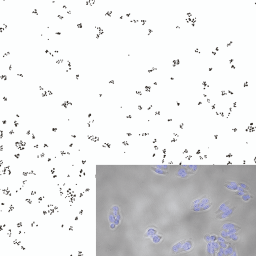The nearest neighbor nuclei method to objectify analysis of pertussis toxin-induced clustering
Main Article Content
Abstract
The in vivo histamine sensitization test (HIST) has historically been performed to guarantee the safety of acellular pertussis vaccine batches. Non-compliance of batches is primarily associated with the presence of low levels of pertussis toxin (PTx). Because of ethical, standardization and scientific reasons, a variety of alternative in vitro approaches have been studied to replace the lethal HIST. A broadly applied and partially accepted method is the CHO cell clustering test, which is based on the clustered growth pattern of CHO cells when exposed to minute amounts of PTx. One of the major hurdles for global application of the CHO clustering test is the manual assessment of the clusters, which is associated with suboptimal reproducibility of test outcomes and is time-consuming. Here, various parameters of CHO cell nuclei were evaluated in search for a reliable, objective read-out parameter. We demonstrate that the distance between each nucleus and its nearest neighbor (3N method) is the most suitable parameter to assess clustered cell growth. This method detects 2.8 mIU PTx/mL and thereby complies with the requirement set for the sensitivity of the CHO clustering test based on visual reading. In commercial acellular pertussis vaccines spiked with PTx, the method detects 45 mIU/mL PTx, which is substantially lower than the 181-725 mIU/mL PTx detected by visual interpretation. The 3N method thus allows objective and sensitive assessment of CHO clustering and thereby encourages broad and global implementation of the in vitro test as an alternative to the HIST.
Article Details

This work is licensed under a Creative Commons Attribution 4.0 International License.
Articles are distributed under the terms of the Creative Commons Attribution 4.0 International license (http://creativecommons.org/licenses/by/4.0/), which permits unrestricted use, distribution and reproduction in any medium, provided the original work is appropriately cited (CC-BY). Copyright on any article in ALTEX is retained by the author(s).
Arciniega, J., Wagner, L., Prymula, R. et al. (2016). Alternatives to HIST for acellular pertussis vaccines: Progress and challenges in replacement. Pharmeur Bio Sci Notes 2016-04, 82-96.
Bache, C., Hoonakker, M., Hendriksen, C. et al. (2012). Workshop on animal free detection of pertussis toxin in vaccines – Alternatives to the histamine sensitisation test. Biologicals 40, 309-311. doi:10.1016/j.biologicals.2012.04.002
Bergman, R. K. and Munoz, J. (1965). Circulatory collapse in anaphylaxis and histamine toxicity in mice. J Immunol 95, 1-8.
Black, W. J., Munoz, J. J., Peacock, M. G. et al. (1988). ADP-ribosyltransferase activity of pertussis toxin and immunomodulation by Bordetella pertussis. Science 240, 656-659. doi:10.1126/science.2896387
De Mattia, F., Chapsal, J. M., Descamps, J. et al. (2011). The consistency approach for quality control of vaccines – A strategy to improve quality control and implement 3Rs. Biologicals 39, 59-65. doi:10.1016/j.biologicals.2010.12.001
Hewlett, E. L., Sauer, K. T., Myers, G. A. et al. (1983). Induction of a novel morphological response in Chinese hamster ovary cells by pertussis toxin. Infect Immun 40, 1198-1203. doi:10.1128/iai.40.3.1198-1203.1983
Hoonakker, M., Arciniega, J. and Hendriksen, C. (2017). Safety testing of acellular pertussis vaccines: Use of animals and 3Rs alternatives. Hum Vaccin Immunother 13, 2522-2530. doi:10.1080/21645515.2017.1349585
ICH (2005). Q2(R1) Validation of Analytical Procedures: Text and Methodology. https://www.ema.europa.eu/en/ich-q2-r1-validation-analytical-procedures-text-methodology
Isbrucker, R., Wagner, L., Daas, A. et al. (2016). Transferability study of CHO cell clustering assays for monitoring of pertussis toxin activity in acellular pertussis vaccines. Pharmeur Bio Sci Notes 2016-05, 97-114.
Katada, T., Tamura, M. and Ui, M. (1983). The A protomer of islet-activating protein, pertussis toxin, as an active peptide catalyzing ADP-ribosylation of a membrane protein. Arch Biochem Biophys 224, 290-298. doi:10.1016/0003-9861(83)90212-6
Kind, L. S. (1958). The altered reactivity of mice after inoculation with Bordetella pertussis vaccine. Bacteriol Rev 22, 173-182. doi:10.1128/br.22.3.173-182.1958
Markey, K., Douglas-Bardsley, A., Hockley, J. et al. (2018). Calibration of pertussis toxin BRP batch 1 in a standardised CHO cell-based clustering assay. Pharmeur Bio Sci Notes 2018, 112-123.
Markey, K., Asokanathan, C. and Feavers, I. (2019). Assays for determining pertussis toxin activity in acellular pertussis vaccines. Toxins (Basel) 11, 417. doi:10.3390/toxins11070417
Ph. Eur. – European Pharmacopoeia (2020a). Pertussis vaccines (acellular, co-purified, adsorbed) 1595.
Ph. Eur. (2020b). Residual pertussis toxin 2.6.33.
Pittman, M. (1984). The concept of pertussis as a toxin-mediated disease. Pediatr Infect Dis 3, 467-486. doi:10.1097/00006454-198409000-00019
Plaut, R. D. and Carbonetti, N. H. (2008). Retrograde transport of pertussis toxin in the mammalian cell. Cell Microbiol 10, 1130-1139. doi:10.1111/j.1462-5822.2007.01115.x
Sato, H., Ito, A., Chiba, J. et al. (1984). Monoclonal antibody against pertussis toxin: Effect on toxin activity and pertussis infections. Infect Immun 46, 422-428. doi:10.1128/iai.46.2.422-428.1984
Tamura, M., Nogimori, K., Murai, S. et al. (1982). Subunit structure of islet-activating protein, pertussis toxin, in conformity with the A-B model. Biochemistry 21, 5516-5522. doi:10.1021/bi00265a021
Wagner, L., Isbrucker, R., Locht, C. et al. (2016). In search of acceptable alternatives to the murine histamine sensitisation test (HIST): What is possible and practical? Pharmeur Bio Sci Notes 2016, 151-170.
Wagner, L. D., Corvette, L. J., Ngundi, M. M. et al. (2017). Towards replacement of the acellular pertussis vaccine safety test: Comparison of in vitro cytotoxic activity and in vivo activity in mice. Vaccine 35, 7160-7165. doi:10.1016/j.vaccine.2017.10.082
Xing, D., Das, R. G., Newland, P. et al. (2002). Comparison of the bioactivity of reference preparations for assaying Bordetella pertussis toxin activity in vaccines by the histamine sensitisation and Chinese hamster ovary-cell tests: Assessment of validity of expression of activity in terms of protein concentration. Vaccine 20, 3535-3542. doi:10.1016/S0264-410X(02)00338-9
Xing, D., Maes, A., Behr-Gross, M. E. et al. (2010). Collaborative study for the standardisation of the histamine sensitizing test in mice and the CHO cell-based assay for the residual toxicity testing of acellular pertussis vaccines. Pharmeur Bio Sci Notes 2010, 51-63.


